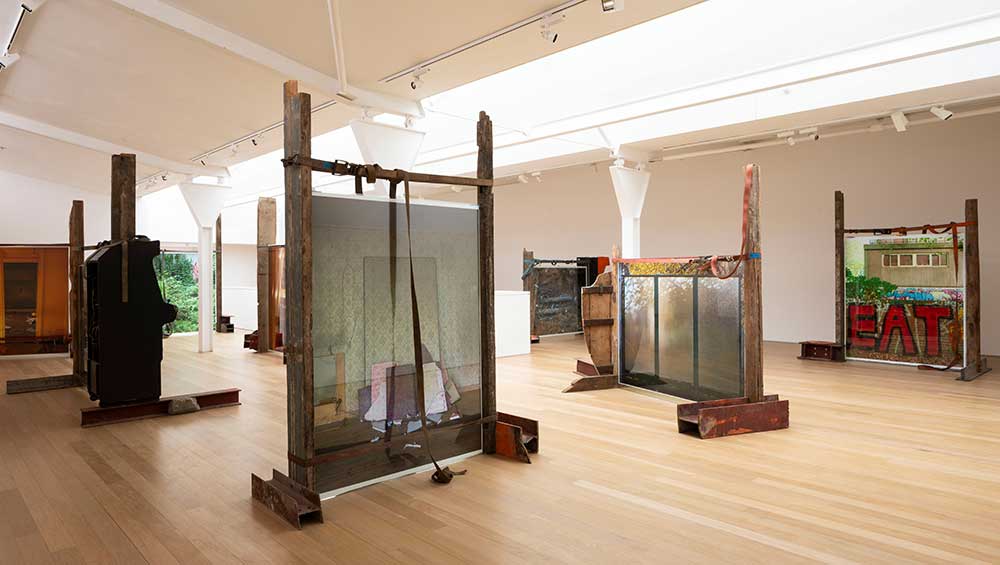
Mike Nelson: Humpty Dumpty: a transient history of Mardin earthworks: low rise, installation view, Fruitmarket, Edinburgh, 2025. Photo: Ruth Clark.
Fruitmarket, Edinburgh
27 June – 5 October 2025
by BETH WILLIAMSON
With Mike Nelson’s new exhibition at Edinburgh’s Fruitmarket you essentially get three exhibitions for the price of one. In an incredible feat of production, Nelson has filled all three gallery spaces in different but connected fashions. With imagery and architecture that largely seems to foreground dilapidation, demolition and disappearance, there is also evidence of construction, redevelopment and reconstruction. It brings together two earlier moments in Nelson’s work in new ways – his experience of the old hilltop city of Mardin in south-east Turkey during the Mardin Biennial of 2012, and Low Rise, a work that Nelson ceased making during its construction in 2014. Just over a decade later, these two moments are brought together at Fruitmarket and resurrected in new forms.
This is not straightforward, for as Nelson has said: “The idea of trying to unravel history I’ve made for myself and reconstruct it is rather daunting, not just in physical terms, but in emotional terms as well.” Of course, Nelson isn’t reconstructing here, but there are surely the same physical and emotional challenges. Still, this is entirely on brand for Nelson for whom one work seems to spawn another. As the art historian Helen Hughes explained in her essay for the Hayward retrospective in 2023: “Mike Nelson’s work poses something of a conundrum in terms of structure. It is so internally consistent and interlinked – in the sense that one work begets the next, whilst simultaneously reaching back in time to evoke a much earlier piece – that it is hard to say definitively where one work ends and another begins.”
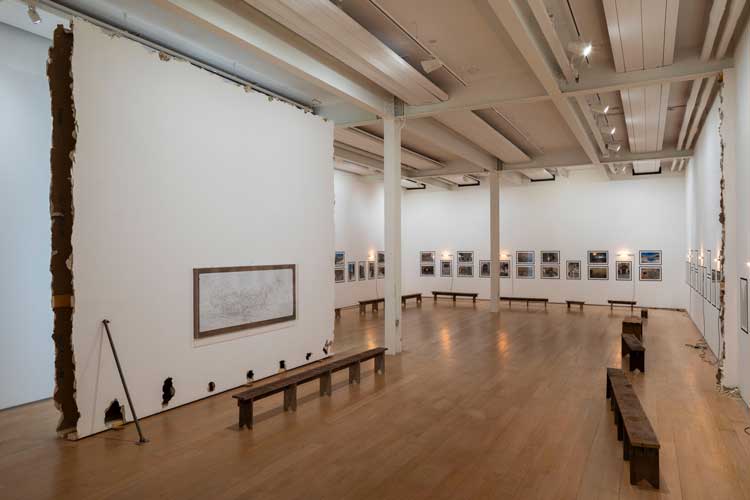
Mike Nelson: a transient history of Mardin earthworks, installation view, Fruitmarket, Edinburgh, 2025. Photo: Ruth Clark.
The conundrum that Hughes recognises is doubly present in Humpty Dumpty since Nelson has turned the Fruitmarket’s warehouse space into a site of production as well as being part of the exhibition itself. Where does the site of production end and the exhibition begin? It is almost impossible to say. The two “approximations of flats” (based on the now demolished Heygate Estate in south London) that he has constructed in the Warehouse are highly emotionally charged spaces although how we experience those spaces is deeply personal. Some visitors felt unnerved inside the stripped-out rooms while others felt a sense of calm. Nelson says people bring their own baggage to these works and he is probably right. For me, the pared-back interiors, containing only fragments or signs of their imagined former domestic purpose, were akin to turning down the volume on life for a while. It allowed for attention to be paid to what was present. In this case, a digital photographic printer from the time of Nelson’s original encounter with Low Rise in 2014, and on the cusp of obsolescence, is used to print all the images for the exhibition. That includes those of Mardin in the Lower Gallery, as well as those in the Upper Gallery of the preparatory images made of the low-rise flats taken before the partial realisation of the initial project. I will return to both of these later.
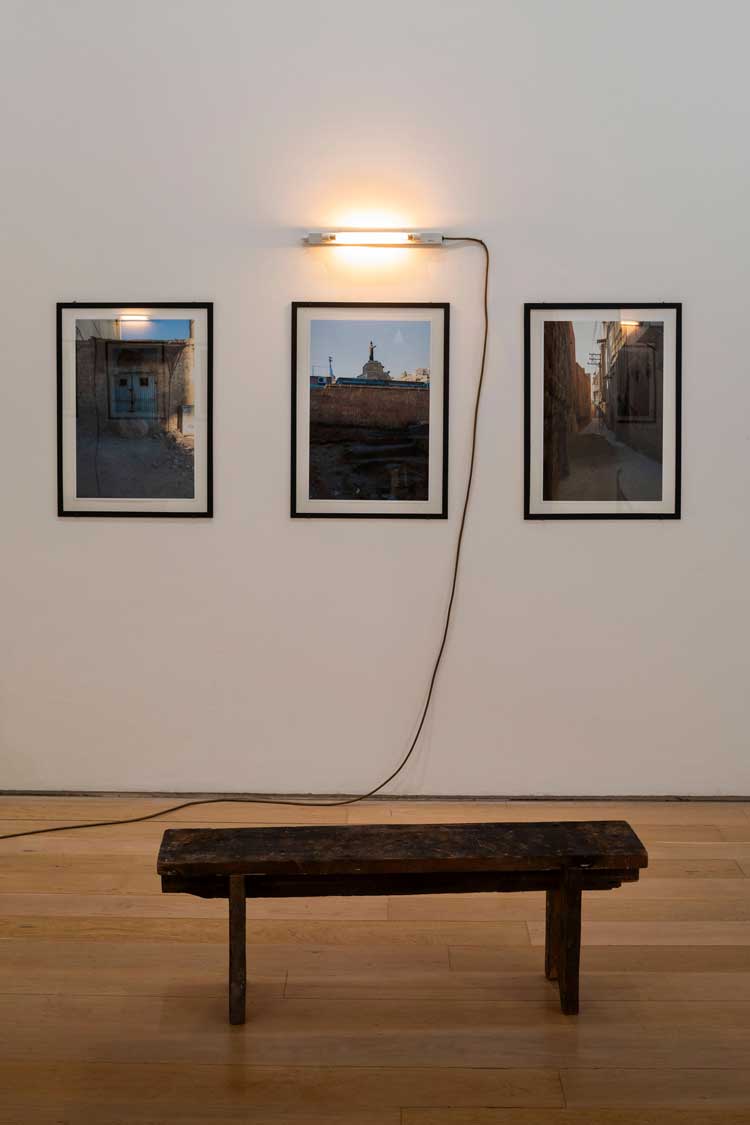
Mike Nelson: a transient history of Mardin earthworks, installation view, Fruitmarket, Edinburgh, 2025. Photo: Ruth Clark.
The exhibition’s title, Humpty Dumpty, may not make immediate sense, but Nelson explains that it is about the inability “to put things back together again” once they are broken. He mentions Robert Smithson, who referenced this in relation to entropy in an interview entitled Entropy Made Visible in 1973. In that interview, Smithson says: “Perhaps a nice succinct definition of entropy would be Humpty Dumpty.” It cannot be rebuilt. Nelson also looks to Jorge Luis Borges’ On Exactitude in Science, in which a country commissions a map the size of itself and coincides with it point for point. Eventually, future generations become less interested in maintaining the map and the country and both are neglected and fall into disrepair. Nelson’s interest in entropic landscapes weaves through this exhibition like a guiding thread.
The Warehouse space with its “approximations of flats” is full of supporting timbers and girders that send us to the Upper Gallery for more. Here, we see the images of the low-rise blocks printed downstairs in the Warehouse. Printed to appear full-scale, they invoke what has already been demolished. Nelson is clear that what is invoked is not simply the lost buildings, but the families they housed and the ideologies that led to them being built in the first place. The images are held between sheets of glass and supported by sections of heavy timber and girders.
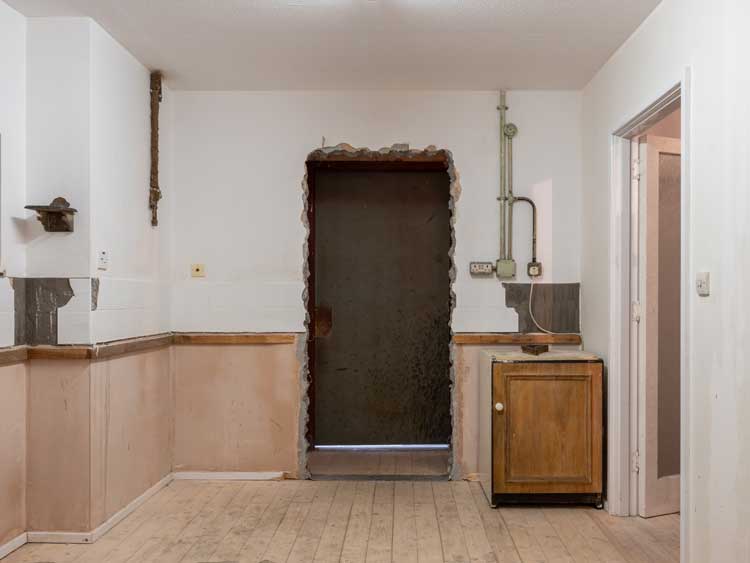
Mike Nelson: low rise, installation view, Fruitmarket Warehouse, Edinburgh, 2025. Photo: Tom Nolan.
Overgrown weeds fill one frame with foliage that itself conceals discarded items, including a sofa. Another image shows stairs to nowhere and yet another shows a graffitied Humpty Dumpty figure. Elsewhere, there is mention of Home Sweet Home, surely ironic. Ripped-out interiors reveal remnants of a family kitchen and fragments of once carefully chosen wallpaper cover walls in various states of disrepair. These are homes already abandoned to a contemporary entropic condition, perhaps not quite what Smithson or even writers such as JG Ballard imagined, but a physical, social and ideological abandon that has damaged the communities left in its wake.
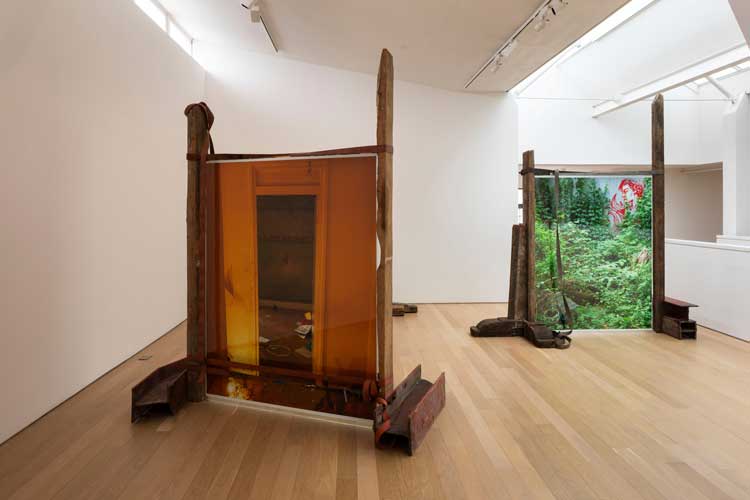
Mike Nelson: Humpty Dumpty: a transient history of Mardin earthworks: low rise, installation view, Fruitmarket, Edinburgh, 2025. Photo: Ruth Clark.
Entropy looms large in the Lower Gallery, too, where “A transient history of Mardin earthworks” plays out across the entirety of the space. Mardin sits in the Artuklu District of Mardin Province, where it is known for the Artuqid architecture of its old town and its strategic location atop a hill close to the Tigris. Nelson walked around the city during the biennial in 2012. He photographed and documented what he saw – a city under redevelopment. He witnessed the excavations and reconstruction necessary for the redevelopment of the city’s infrastructure – drainage, water and internet provision. The photographs shown here relate to a hand-annotated map that plots their locations. Nelson says he renamed the trenches, piles and constructions “earthworks” – borrowing from Smithson again. Smithson, for his part, borrowed from the writer Brian Aldiss, whose 1965 science fiction novel Earthworks provided him with the idea. I suppose what Nelson sees in Mardin is the same connection between unsustainable development, ecological disaster and politics that Aldiss envisaged in his novel and Smithson explored in one way or another in works such as Partially Buried Woodshed (1970) created at Kent State University in Ohio. Similarly, Nelson sees the politics and the infrastructure of Mardin being buried and made invisible. There are hints of Ballard and William Burroughs here, too, except that Nelson is more interested in making his arguments and ideas through materials and space. It is the immersive experience of his works, physically, mentally and emotionally, that leave us reeling, wondering what it is we are doing to the world and why. It is an almost impossible question to answer.
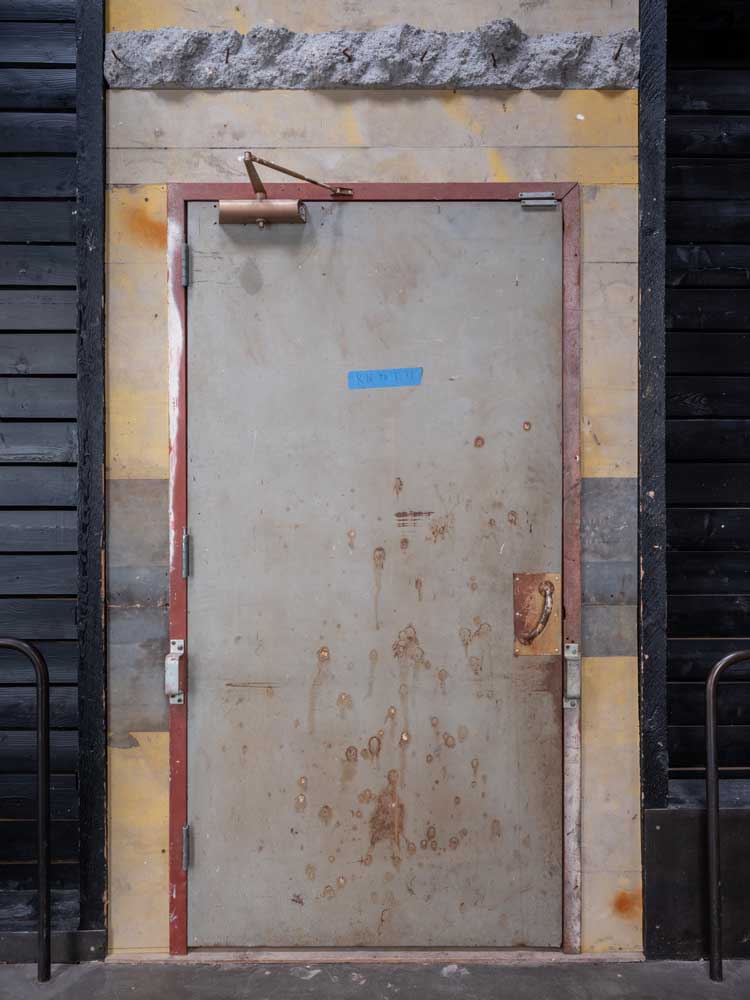
Mike Nelson: low rise, installation view, Fruitmarket Warehouse, Edinburgh, 2025. Photo: Tom Nolan.